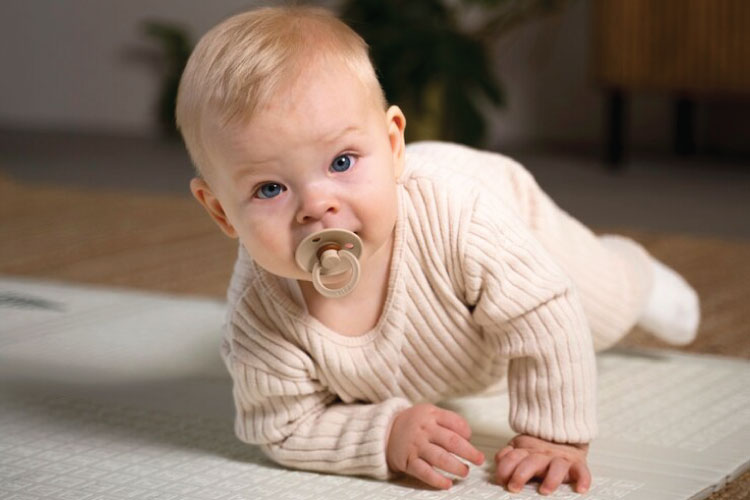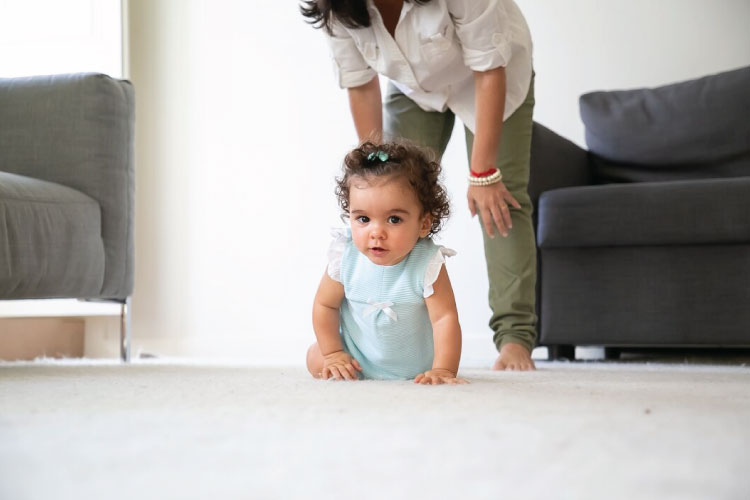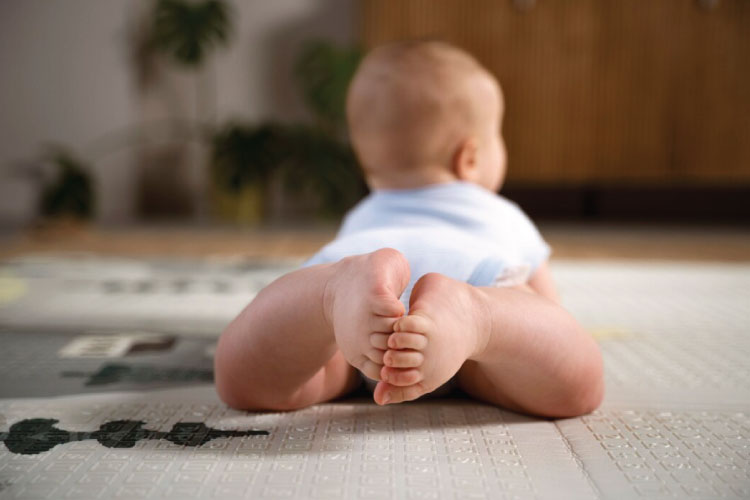One of a baby’s most significant developmental milestones is learning to crawl because it enables them to explore their surroundings, hone their motor skills, and get ready to walk. Even though learning to crawl is a much-anticipated milestone, some parents may become worried when a baby crawls backward rather than forward. So, why do some babies crawl backward?
Doubts will be pouring into their minds. Does this indicate a delay or a problem? Should they let their child handle it or step in to correct the baby? Well, during the stages of learning to crawl, many babies crawl backward, which is a normal developmental stage. And it is not a sign of any disorder or issue; rather, it shows how strong, coordinated, and curious they are becoming.
When Does A Baby Start Crawling?
Babies typically start crawling between the ages of 6 to 10 months, although the exact timing can vary widely from one child to another. Some babies may start crawling as early as 6 months, while others might not begin until closer to their first birthday.
It’s important to remember that every baby develops at their own pace, and there is a wide range of normal when it comes to reaching developmental milestones like crawling.
Before crawling, babies usually go through a phase of scooting, rolling, or rocking on their hands and knees. Some babies scoot backward on their backs. These movements help strengthen their muscles and develop the coordination necessary for crawling. Once they gain enough strength and confidence, they’ll begin to crawl on their hands and knees, exploring their environment and gaining a new level of independence.
Related Reading: How To Make A Baby Laugh? 12 Ways To Make Her Giggle!
Some babies will not crawl. It is not uncommon for babies to shuffle on the bottom, crawl along on the belly, or move straight from sitting to standing.
Does Moving Backward Count As Crawling?

Moving backward is considered a part of crawling because it involves many of the same developmental skills and muscle movements as forward crawling. Crawling, whether it’s forward, backward, or in any direction, is a complex motor skill that requires a baby to coordinate various muscle groups.
Here’s why moving backward is considered a form of crawling:
- Muscle Development: Crawling involves using the muscles in the arms, legs, and core to propel the body forward or backward. Moving backward helps babies strengthen these muscles, which are essential for crawling in any direction.
- Coordination: Both forward and backward crawling require a baby to coordinate the movement of their arms and legs while maintaining balance on their hands and knees. This coordination is a critical aspect of the crawling process.
- Spatial Awareness: Moving backward requires a baby to be aware of their surroundings and adjust their movements accordingly. This helps them develop spatial awareness and an understanding of how their body moves about objects and the environment.
- Motor Skills: Crawling, whether forward or backward, promotes the development of fine and gross motor skills. Babies learn to control their body movements, improve their hand-eye coordination, and refine their motor planning abilities.
- Exploration: Crawling in any direction allows babies to explore their environment and interact with objects from different angles. This exploration is important for cognitive and sensory development.
Related Reading: 12 Fun And Learning (Activities For Babies 0-6 Months)
Thus, while forward crawling is often the more recognized form of crawling, moving backward is a natural and important part of the developmental process. It’s all about babies gradually mastering the skills needed for independent movement and exploration.
Why Do Babies Crawl Backward?
Babies’ ability to crawl can evolve as they progress through different stages of motor development. Backward crawling might be a temporary phase that a baby goes through as they refine their crawling skills and eventually transition to forward crawling or other forms of movement.
Here are some reasons why babies crawl backward:
1. They may find it easier to crawl backward
Some infants choose to crawl backward because it is easier than crawling forward. Crawling forward is generally considered a more advanced and complex motor skill for babies compared to crawling backward.
Crawling forward requires more strength in the legs and hips. It involves coordination of movements, balance, and strength, as babies need to coordinate their arms and legs to move in a coordinated manner. It also requires them to develop the ability to shift their weight and maintain balance while moving.
Crawling backward, on the other hand, maybe a simpler motion for babies to perform, as it often involves pushing off with the legs and using the arms to drag themselves backward.
Crawling backward relies more on the arms and shoulders, which are usually stronger in babies. Therefore, some babies may find it easier to push themselves backward with their arms than to pull themselves forward with their legs.
2. Involves different muscle groups
Crawling backward requires different muscle groups to be engaged compared to forward crawling1. For example, crawling backward engages the biceps and the muscles in the upper back and shoulders.
Likewise, it engages the leg muscles, including the quadriceps, hamstrings, and calf muscles (gastrocnemius). Babies might be strengthening specific muscle groups or working on their balance by experimenting with backward crawling.
3. Babies might feel more powerful with their arms than their legs
Some infants might feel more powerful in their arms than in their legs, so they may push or scoot backward with their arms. The baby’s preferences and personality are also involved in this. Some babies may enjoy using their arms more than their legs, or they may feel more confident and comfortable with their upper body than their lower body. Therefore, they may use their arms to move around, even if it means going backward.
Related Reading: Cold Hands And Feet In Babies – Why It Happens And What To Do
4. The upper bodies of babies may be more developed than the lower ones
Some babies may have more developed upper bodies than lower ones, which is why they may crawl backward. This is related to the baby’s physical development and growth. Some babies may have more muscle mass and tone in their upper bodies than their lower ones, especially if they have had a lot of tummy time and practice lifting their heads and chests.
This may give them an advantage in crawling backward, as they can use their upper body strength to propel themselves.
Is It Normal For A Baby To Crawl Backward?
Yes, it can be normal for a baby to crawl backward as part of their developmental exploration and motor skill progression. Crawling is a complex motor skill that involves coordination, strength, and balance, and babies often experiment with different movements and patterns as they learn to navigate their environment.
However, if your baby exclusively crawls backward and shows no interest in or attempts at forward crawling, or if you have other concerns about their overall development, it’s a good idea to discuss your observations with a pediatrician or a developmental specialist.
Note: 1-year-old crawling backward is a cause for concern. One-year-olds who crawl backward may be experiencing a neurological problem or developmental delay. Typically, infants progress from crawling forward to walking between the ages of 9 to 12 months.
Crawling backward may suggest a lack of necessary motor skill development or could be a sign of a neurological issue that requires assessment by a medical professional to ensure the child’s physical and cognitive development is on track.
How Long Do Babies Crawl Backward Before Crawling Forward?
There is considerable variation in the timing and order of a baby’s developmental milestones, and every baby develops at a different pace.
It can vary greatly from child to child how long a baby spends crawling backward before progressing to forward crawling. A baby’s development is unique and influenced by many factors, including their motor skills, coordination, strength, and overall developmental pace. Therefore, there is no set timeline for this transition.
It may only be a matter of time before some babies try forward crawling or other forms of movement after crawling backward for a short time. In other cases, backward crawling may be explored for a longer period before progressing to forward crawling.
How To Help Your Baby Crawl Forward?

Babies crawling backward will eventually learn to crawl forward with time and practice. There is no need for parents to worry or intervene, as this is a natural and healthy part of development. However, parents can help their baby crawl forward by doing the following:
- Place interesting toys or objects in front of the baby, just out of their reach. This will motivate them to move toward them, even if it means crawling forward. Babies frequently find their reflections to be fascinating. Place a baby-safe mirror in front of them to attract their attention and motivate them to move.
- Parents can also praise and encourage the baby when they make any attempt to crawl forward.
- A demonstration of crawling may help. Get down on the floor and demonstrate crawling yourself. Babies often learn by imitation, so seeing you crawl can inspire them to try it themselves.
- Play games with the baby that involve crawling forward, such as catch and chase, peek-a-boo, or obstacle courses. These games will make crawling fun and exciting for the baby, as well as challenge them to use their legs and hips more.
- Give the baby plenty of floor time and space to explore. The more opportunities the baby has to crawl, the more they will practice and improve their skills. Parents should also make sure that the floor is safe and supervised, and that there are no potential hazards or obstacles that could harm or discourage the baby.
Related Reading: 10 Ways To Encourage A Baby To Walk- Mini Steps!
When To Go The Doctor?
While crawling backward can be a normal part of a baby’s exploration and motor skill development, there are certain situations where it might be a good idea to consult a doctor or a pediatrician:
- Baby crawling backward on their head: Crawling backward on their head is not a common or typical behavior for babies and could potentially indicate an underlying issue that should be addressed by a doctor. Here are a few scenarios that could result in a baby displaying this peculiar behavior2:
- Muscle weakness or imbalance
- Certain medical conditions or issues with muscle tone
- Motor skill development delay
- Sensory processing challenges
- Balance and coordination issues
2. Persistent Backward Crawling: If your baby exclusively crawls backward and shows no signs of attempting forward crawling or other developmental milestones, it might be worth discussing with a doctor to ensure there are no underlying motor or developmental issues.
Issues like muscle spasticity (increased muscle tone) or hypotonia (decreased muscle tone) could impact a baby’s crawling style. These conditions might affect the coordination and strength needed for forward crawling.
3. Lack of Progression: If your baby’s crawling skills do not seem to be progressing over time, or if they continue to struggle with coordination and movement despite consistent efforts, it’s a good idea to seek professional advice. Remember that early intervention and support can make a significant difference in addressing any developmental challenges your baby might be facing.
4. Unilateral Movements: Unilateral crawling, also known as “asymmetric crawling,” occurs when a baby predominantly uses one side of their body to move forward while crawling, instead of using alternating movements of both arms and legs.
If your baby consistently uses only one side of their body while crawling backward or shows significant asymmetry in their movements, this could potentially indicate a need for further evaluation.
5. Other Developmental Concerns: If you notice other developmental delays, such as speech, social interaction, or fine motor skills, in addition to the backward crawling pattern, it’s important to consult a doctor for a comprehensive assessment.
Not to mention, it is always best to consult a professional and err on the side of caution if you feel that something is amiss with your baby’s development.
Conclusion
Babies go through different stages of motor development, and their crawling abilities can evolve. Baby crawling backward is a normal and beneficial stage of development that happens to many babies as they are learning to crawl. It is not a sign of any problem or disorder, but rather a sign of their developing strength, coordination, and curiosity.
Parents can support their babies by providing them with toys, games, and floor time that will encourage them to crawl forward. Crawling backward is not something to worry about, but rather something to celebrate as the baby is exploring and exercising their independence.


